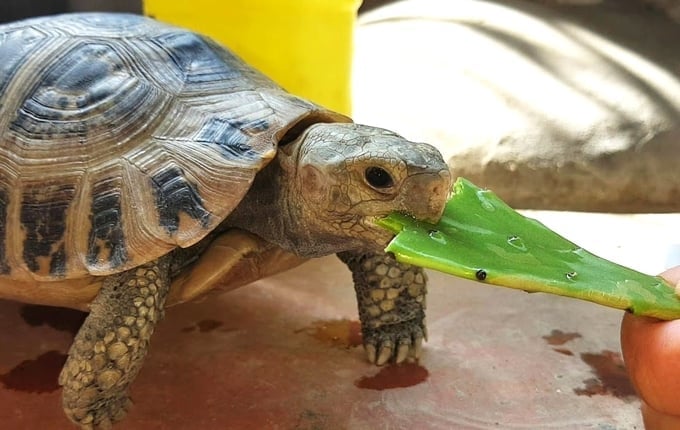December 5, 2025 | 23:13 GMT +7
December 5, 2025 | 23:13 GMT +7
Hotline: 0913.378.918
December 5, 2025 | 23:13 GMT +7
Hotline: 0913.378.918
As zoonotic diseases continue to rise, the wildlife trade has been identified as a high-risk link in the chain. To help manage these risks early on, the World Organisation for Animal Health (WOAH) has released the Wildlife Trade Disease Risk Mitigation Guidelines for relevant authorities, promoting a comprehensive and One Health approach that balances economic benefits, conservation, and public health.
Nguyen Ngoc Tien, a representative from the Department of Livestock Production and Animal Health, considers WOAH’s guidelines a scientific and holistic advancement, particularly well-suited for assessing disease risks in Vietnam’s wildlife trade and consumption chain. However, he emphasized that effective implementation starts with identifying all potential risk points.

A representative of the Department of Animal Health and Production proposed that it is necessary to develop a clear and unified process for each stage to minimize the risk of disease arising from this activity. Photo: ENV.
“We deal with three main wildlife sources: free-ranging species, legally farmed species, and species banned from hunting. Each group has distinct characteristics that require separate assessments,” Tien explained. He suggested mapping out all stakeholders in the chain, from hunters, transporters, breeders, and slaughterers to consumers and law enforcement officials, such as forest rangers and market inspectors.
“Only by identifying all participants can we determine who poses the highest risk, and design appropriate control measures accordingly,” the Department's representative stressed.
Tien also noted that while Vietnam has a fairly complete legal framework for wildlife protection, it still lacks a standardized protocol for sampling, testing, handling confiscated animals, and protecting frontline workers who come into direct contact with wildlife.
Every day, hundreds of wild animals are confiscated and transferred to rescue centers by Vietnamese law enforcement. However, Jake Brunner, Regional Director of IUCN for the Lower Mekong Subregion, emphasized that rescue is only a temporary solution, not a sustainable way to manage disease risks.

Jake Brunner, Regional Director of IUCN for the Lower Mekong Subregion. Ảnh: Linh Linh.
“I'd like to emphasize that the best way of reducing any risk of reintroduction, of course, is to reduce the rate at which animals are being poached and removed from the forest in the first place”, Brunner said. Yet, he argued that the most effective method is to focus on the upstream prevention.
“As soon as that animal is taken from the forest, its survival rate goes down, the costs to the state in terms of handling, confiscating, and handling these animals go up. And at the same time, Vietnam's biodiversity is being reduced and damaged”, he warned.
One Health Partnership (OHP) Framework provides an institutional framework, co-led by the Ministry of Agriculture and the Environment and the Ministry of Health, with about 40 development partners and international NGOs and research centers, so it provides a comprehensive and operational institutional structure within which the work of IUCN and many other partners can operate.
“And the strategy is to use OHP to convene partners to share information, to discuss the policy implications. So that's our strategy”, he shared.
According to Pawin Padungtod, Senior Technical Coordinator at ECTAD (FAO), there needs to be a clear distinction between risks posed by captive and wild animals. For captive species, biosecurity measures used in livestock farming, such as separation, hygiene, and disinfection, can be applied.

Mr. Serge Morand, member of the One Health Senior Advisory Board of the WHOA, WHO, FAO, UNEP Alliance, shared at the Special Meeting on Controlling Disease Risks in Wildlife Trade. Photo: Thanh Thuy.
“But for animals in the wild, then, then I think it's up to the people who visit their habitats, you know, to protect themselves. And this can also be achieved by using basic hygiene principles, for example, washing hands, keeping clean”, he recommended.
At the technical session on disease risk control in wildlife trade, Serge Morand, a member of the High-Level One Health Expert Panel of the WHOA-WHO-FAO-UNEP alliance, stated that this integrated approach is crucial for countries seeking to manage animal health, particularly that of wildlife, more effectively.
“Vietnam is taking bold steps in areas still under-prioritized in many countries, such as ecosystem health, wildlife health, and biodiversity conservation under the One Health framework. This approach promises stronger outcomes in mitigating zoonotic disease risks, not only in livestock and wildlife, but also for human health,” Morand affirmed.
Translated by Linh Linh

(VAN) As of 2025, the ASEAN region has a total of 69 ASEAN Heritage Parks recognized across its 10 member states. Among them, Viet Nam contributes 15 ASEAN Heritage Parks.

(VAN) Yok Don National Park has high biodiversity with numerous endemic plant and animal species, and it is also the only dipterocarp forest ecosystem conservation area in Viet Nam.

(VAN) Viet Nam and Brunei signed two important MOUs on fisheries and IUU, expanding cooperation in agriculture, the environment, and Halal exports, aiming to substantively implement joint projects.

(VAN) The Viet Nam Coconut Association worked with the International Finance Corporation (IFC) and businesses to promote the supply chain, enhance competitiveness, and develop the coconut industry sustainably.
![Hue aims for Net Zero: [2] Pioneering low-emission tourism](https://t.ex-cdn.com/nongnghiepmoitruong.vn/608w/files/huytd/2025/12/04/0633-dulichzero-4-095634_236-161125.jpg)
(VAN) The ancient capital of Hue has developed Net Zero tourism products and models, aiming to reduce carbon emissions and pioneer the establishment of Viet Nam's green tourism destination.

(VAN) C.P. Viet Nam has announced the successful completion of its goal to plant 1.5 million trees during the 2021-2025 period, a key milestone within company's long-term ESG strategy and its roadmap for emission reduction.

(VAN) This is an initiative of MAE aimed at creating a unified coordination mechanism to implement agricultural cooperation programs with developing countries.